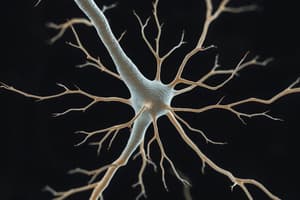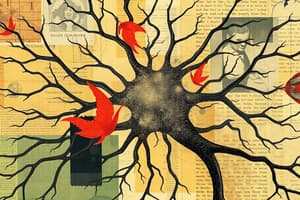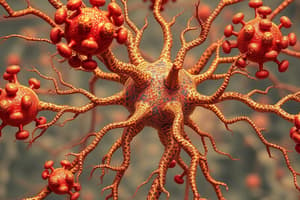Podcast
Questions and Answers
What is acetylcholinesterase?
What is acetylcholinesterase?
An enzyme that catalyzes the breakdown of acetylcholine into choline and acetate.
In order name the events that signal transmission at a chemical synapse: The action potential arrives at the ______
In order name the events that signal transmission at a chemical synapse: The action potential arrives at the ______
synapse
What happens when the action potential arrives at the chemical synapse?
What happens when the action potential arrives at the chemical synapse?
Causes the voltage-gated Ca2+ channels to open.
What do calcium ions bind to in the process of neurotransmitter release?
What do calcium ions bind to in the process of neurotransmitter release?
What do the vesicles release during neurotransmission?
What do the vesicles release during neurotransmission?
How does saltatory conduction work?
How does saltatory conduction work?
Which of the following statements about events in saltatory conduction is true?
Which of the following statements about events in saltatory conduction is true?
The current in a myelinated axon can leak out through the membrane.
The current in a myelinated axon can leak out through the membrane.
What is the Axon Hillock?
What is the Axon Hillock?
What is the Soma?
What is the Soma?
What are Dendrites?
What are Dendrites?
What is the function of the Axon Hillock?
What is the function of the Axon Hillock?
What are Neurons?
What are Neurons?
What is Membrane Potential?
What is Membrane Potential?
What is the structure and function of the Axon Hillock?
What is the structure and function of the Axon Hillock?
What are Schwann Cells?
What are Schwann Cells?
What are Axon Terminals?
What are Axon Terminals?
When does an action potential occur?
When does an action potential occur?
What is the usual resting membrane potential?
What is the usual resting membrane potential?
What is the function of the myelin sheath?
What is the function of the myelin sheath?
What is the Nernst equation?
What is the Nernst equation?
Define the difference between a capacitor and an insulator.
Define the difference between a capacitor and an insulator.
When using the Goldman equation, what must be considered?
When using the Goldman equation, what must be considered?
What are the phases of a typical action potential?
What are the phases of a typical action potential?
What happens after the voltage-gated Na+ channels open?
What happens after the voltage-gated Na+ channels open?
What is the job of intracellular Ca2+?
What is the job of intracellular Ca2+?
What is synaptic transmission?
What is synaptic transmission?
What influences neurotransmitter release?
What influences neurotransmitter release?
What are the classifications of neurotransmitters?
What are the classifications of neurotransmitters?
Describe acetylcholine.
Describe acetylcholine.
What are glial cells?
What are glial cells?
What is multiple sclerosis?
What is multiple sclerosis?
Study Notes
Neuron Structure and Function
- Axon Hillock: Initiates action potentials; integration point for incoming signals from dendrites and cell body.
- Soma: Cell body containing nucleus and organelles, processes around 10,000 inputs.
- Dendrites: Branched extensions that transmit signals toward the soma.
- Function of Axon Hillock: Determines if an action potential will occur; operates on an all-or-nothing principle.
Neuron Characteristics
- Neurons: Primary excitable cells responsible for processing and transmitting information.
- Membrane Potential: Voltage difference across cell membranes, essential for neuron function.
Axon Structure and Function
- Axon: Slender extension for signal conduction, specialized for rapid transmission; arises from the axon hillock.
- Myelin Sheath: Insulating layer formed by Schwann cells in the PNS, increases conduction speed.
- Axon Terminal: End of the axon where synapses with target cells occur.
Action Potential Mechanism
- Action Potential: Initiated when a substantial signal reaches the threshold at the axon hillock.
- Voltage-Gated Ion Channels: Essential for rapid depolarization and repolarization during an action potential.
- Phases of Action Potential: Involves sodium channels opening to let Na+ in (depolarization), followed by potassium channels opening to allow K+ out (repolarization).
Membrane and Resting Potentials
- Resting Membrane Potential: Typically around -70 mV; maintained by Na+/K+ ATPase pumping ions against concentration gradients.
- Equilibrium Potential: Established when an ion concentration gradient is balanced by the electrical gradient; influenced by ionic concentration and permeability.
Synaptic Transmission
- Neurotransmitter Release: Triggered by action potentials arriving at synapses, causing Ca2+ influx and vesicle fusion with the membrane.
- Acetylcholine: Major neurotransmitter at neuromuscular junctions, regulated by acetylcholinesterase for signal termination.
- Signal Transmission: Neurotransmitters diffuse across synaptic cleft to bind to receptors, instigating intracellular responses.
Graded vs Action Potentials
- Graded Potentials: Localized changes that vary in strength; important for initiating action potentials at the axon hillock.
- Action Potentials: Long-distance signals that propagate along axons without degradation, driven by voltage-gated channels.
Types of Neurons
- Multipolar Neurons: Multiple dendrites and one axon; commonly found in the CNS.
- Bipolar Neurons: Two main processes; typically seen in sensory systems.
- Unipolar Neurons: One extension; primarily sensory neurons.
Neurotransmitter Classifications
- Types: Include acetylcholine, amino acids, biogenic amines, peptides, and other categories.
- Function: Facilitate communication between neurons and influence various physiological responses.
Supporting Cells and Repair
- Glial Cells: Provide support, nourishment, and protection to neurons; include oligodendrocytes and astrocytes.
- Schwann Cells: Create myelin sheaths in the PNS; crucial for rapid signal transmission.
Disorders and Conditions
- Multiple Sclerosis: Characterized by the breakdown of myelin sheaths in the CNS, impairing signal transmission.
- Myasthenia Gravis: Condition aided by acetylcholinesterase inhibitors to enhance neuromuscular transmission.
Important Terminology
- Saltatory Conduction: Rapid transmission of action potentials along myelinated axons, jumping from one node of Ranvier to the next.
- SNARE Proteins: Involved in neurotransmitter release by facilitating vesicle fusion with the presynaptic membrane.### Events in Saltatory Conduction
- Myelination prevents the loss of electrical charge through the axon membrane, enhancing signal transmission efficiency.
- The action potential initiates when the current at the node of Ranvier exceeds the threshold, leading to the generation of new action potentials.
- Nodes of Ranvier are densely populated with sodium (Na+) and potassium (K+) channels, facilitating rapid ion exchange.
- The action potential propagates by jumping from one node to another, a process termed saltatory conduction, which significantly accelerates signal transmission compared to unmyelinated axons.
- Increased resistance in the internode regions helps maintain the strength of the signal as it travels along the axon, minimizing degradation.
- Saltatory conduction results in faster neural communication, vital for quick reflexes and coordinated movements.
Studying That Suits You
Use AI to generate personalized quizzes and flashcards to suit your learning preferences.
Description
Test your knowledge on the structure and function of neurons, including the roles of the axon hillock, soma, dendrites, and myelin sheath. This quiz will cover essential concepts in neurobiology and how these components work together to transmit signals. Dive deep into the fascinating world of neuronal functions!




